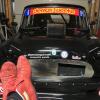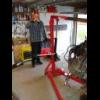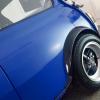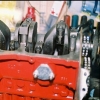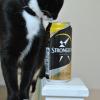Steel Thickness
#1

Posted 10 October 2016 - 09:37 AM
Thanks
#2

Posted 10 October 2016 - 10:02 AM
it depends on which panels you are on about.
#3

Posted 10 October 2016 - 10:16 AM
All external panels are 0.9mm
Floor pans are 0.9mm
Boot floor 0.9mm
Outer and inner sills 0.9mm
Inner wings 0.9mm
Toeboard, now this can vary a little on the age of the car 0.9mm to 1.2mm
Heelboard 1.2mm
Bulkhead crossmember 1.2 to 1.5mm
Floor crossmember 0.9mm
Rear valance 0.9mm
There are other small reinforcement brackets etc which can vary in thickness but none less than 0.9mm.
As a rule of thumb I always have a sheet of 0.9mm and 1.2mm to hand when carrying out repairs.
#4

Posted 10 October 2016 - 06:57 PM
thank you
#5

Posted 10 October 2016 - 07:56 PM
#6

Posted 10 October 2016 - 10:27 PM
Edited by gazza82, 10 October 2016 - 10:27 PM.
#7

Posted 11 October 2016 - 10:09 AM
#8

Posted 11 October 2016 - 10:20 AM
Some Citroën models go down to 0.4mm, which is why the metal has to be corrugated to have any useful amount of stiffness. I don't fancy having to weld one! Certain Renaults are very thin too. One of them relied on the doors being closed for its torsional stiffness. A Mini in good condition, with the monocoque not butchered in any way, has no problems in that area.
That's shocking, I wonder how they perform in a crash.
I saw a Seat Ibiza have a head on with a Mercedes ML a while ago, impact speed was probably over 80mph and the doors on both cars opened with relative ease
#9

Posted 13 October 2016 - 02:09 PM
I would not drive one.
#10

Posted 13 October 2016 - 02:54 PM
how thin do you think the modern cars body sides are?
now they are down to about 0.65mm
#11

Posted 13 October 2016 - 04:40 PM
Tin foil. The wing i changed on my old B5.5 Passat was ridiculously thin, much thinner than a standard mini panel.
I'm sure the 2CV i welded many moons ago had a chassis of 18 gauge and the rest was more like paper.
#12

Posted 15 October 2016 - 02:21 PM
Interesting! I will not be buying a Passat. I hate them anyway, because they were the first to use a plastic fuel tank, and UK law had to be changed to avoid criminalising the owners. Allegedly safe, but we now know about VW and their lies....
Anyway, soon after, one was in a fairly minor shunt on the M25 one Boxing Day, and burned furiously, killing the occupants and those of the car behind. So much for the "safe" plastic tank, which passed all its laboratory tests, which are nothing like real world accidents. It melted and dumped all of its contents in a pool of blazing petrol on the road. I passed by shortly afterwards, the lane was closed off, fire out, and it was clear from the metalwork that it was only a minor 3 car shunt, ordinarily involving maybe some minor whiplash injuries at the most. But 2 cars completely burnt out and one partially burned.... Just not right.
I have seen a 2CV restoration somewhere, possibly linked from the MIG welding forum, and yes it is all thin. But modern cars have increasing quantities of boron steel and all sorts of other things that can't really be repaired. We really are well-off with Minis as regards repairability. Mind you, a Rover P4 might be easier, as the shell is thicker, possibly 1.2mm, with decently thick alloy doors, and the chassis is well within the range of ordinary arc welding. But not so much fun to drive...
#13

Posted 15 October 2016 - 02:56 PM
Opening the bonnet on a 2CV should have been enough to discourage anyone from driving in one. Also the headlamps mounted on a bar, even after they'd dropped the mechanical dipping mechanism, says something about body rigidity.
#14

Posted 15 October 2016 - 04:24 PM
Mmm I had a very serious RTA in my B6 Passat where I was tailed whilst stationary at over 50mph ( The Policeman who interviewed the three of us reckoned it was far in excess but could not prove it as there were no skid marks.) The impact was enough to rip the rear suspension off and push the rear quarters fwd making it incredibly difficult for my mate to get out.Interesting! I will not be buying a Passat. I hate them anyway, because they were the first to use a plastic fuel tank, and UK law had to be changed to avoid criminalising the owners. Allegedly safe, but we now know about VW and their lies....
Anyway, soon after, one was in a fairly minor shunt on the M25 one Boxing Day, and burned furiously, killing the occupants and those of the car behind. So much for the "safe" plastic tank, which passed all its laboratory tests, which are nothing like real world accidents. It melted and dumped all of its contents in a pool of blazing petrol on the road. I passed by shortly afterwards, the lane was closed off, fire out, and it was clear from the metalwork that it was only a minor 3 car shunt, ordinarily involving maybe some minor whiplash injuries at the most. But 2 cars completely burnt out and one partially burned.... Just not right.
I have seen a 2CV restoration somewhere, possibly linked from the MIG welding forum, and yes it is all thin. But modern cars have increasing quantities of boron steel and all sorts of other things that can't really be repaired. We really are well-off with Minis as regards repairability. Mind you, a Rover P4 might be easier, as the shell is thicker, possibly 1.2mm, with decently thick alloy doors, and the chassis is well within the range of ordinary arc welding. But not so much fun to drive...
Nope we did not burn to death, the fuel tank did not rupture and as the Passats have a Ncap rating of 5 all three of us walked away. So a bold statement to make. My car was completely totalled so impressed me that much I went and bought another one.
Any modern car now with have wafer thin panels to keep the weight down from all of the extra luxury items fitted to most of them and of course to keep fuel consumption to a minimum.
#15

Posted 15 October 2016 - 06:47 PM
1 user(s) are reading this topic
0 members, 1 guests, 0 anonymous users




